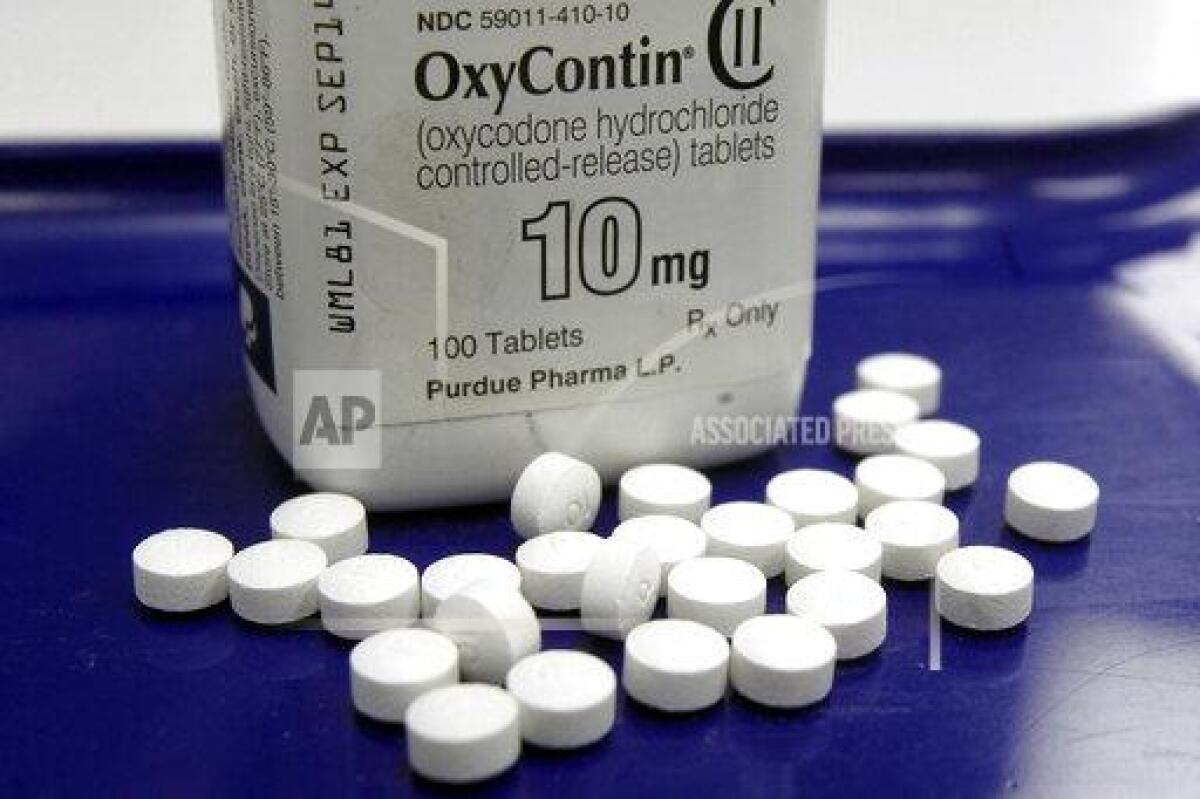Apodaca: Orange County has not been spared from the opioid crisis

- Share via
Chances are you know someone who is addicted to opioids.
A brother or sister. A friend. Perhaps a co-worker or someone you met at church or at a club you belong to. It could even be a person you admire, who appears to be successful, happy and well-adjusted.
What might not be apparent is that they are in trouble and need help.
Opioid addiction is a public health crisis that has grown so big and become so widespread that it touches virtually every one of us in some way. Though the legitimate, responsible use of opioids certainly has its place in medicine, the rampant misuse of these potent, addictive drugs lurked in the shadows for far too long, hiding under the mantle of respectability and the lure of “pain management.”
It scaled up into a full-blown epidemic before most of us understood the depth of the problem, which has by now infiltrated every street in every town, including your own.
“Here at the hospital we see overdoses all the time,” said Dr. Steven Ey, Chief of Service at Hoag Addiction Treatment Centers in Newport Beach.
“This affects all ages, races, sexes. It’s everywhere.”
And it’s getting worse.
A whale-watching tour inspires the Daily Pilot columnist to take a closer look at how information can be rightly or wrongly interpreted.
Drug overdose is now the leading cause of unintentional injury death in the United States, accounting for more deaths than motor vehicle accidents.
Last year more than 93,000 people died of a drug overdose in the U.S., nearly 30% more than in 2019 and the most ever recorded in a single year, according to the Centers for Disease Control and Prevention. Ten states, including California, saw overdose deaths spike by at least 40%.
The vast majority of those deaths nationwide — just shy of 70,000 — were due to opioid overdoses.
The tragedy of these lost lives is compounded by the social and economic toll that addiction to opioids has wrought. The CDC estimates that the misuse of prescription opioids alone costs the nation $78.5 billion a year in healthcare expenses, lost productivity, addiction treatment and criminal justice actions.
Orange County has not been spared.
The death count for opioid overdoses in the county rose to nearly 500 last year, a shocking increase from 2019’s count of 272, according to the Orange County Health Care Agency.
How did we get here?
Beginning in the late 1990s, pharmaceutical companies began aggressively marketing and distributing prescription opioids for the treatment of pain, in many cases falsely assuring physicians and patients that the drugs as formulated were not addictive.
“We made pain the fifth vital sign,” said Dr. Ey. “It became any way to deal with pain was to prescribe opioids.”
As opioid deaths began to skyrocket and awareness grew about addiction to pain pills, authorities began cracking down on the flagrant overprescribing of these powerful drugs. Many lawsuits against drug manufacturers and distributors were filed, leading to multibillion-dollar settlements.
Yet as mitigation and accountability efforts increased and knowledge grew over the dangers regarding the misuse of prescription opioids, the crisis in the past several years shifted. Now it is largely fueled by the easy availability of illicit synthetic opioids — predominantly fentanyl, which is 50 to 100 times more powerful than morphine.
That deadly trend has been exacerbated as fentanyl is also frequently cut into other illegal drugs such as cocaine. Synthetic opioids now account for the majority of total opioid fatalities.
In the past year and a half the opioid epidemic has grown even more dire because of the coronavirus pandemic, which has left many addicts isolated, feeling additional stress and unable to access lifesaving treatment.
Answers won’t come easily to this intractable problem, but efforts are gaining momentum.
Those efforts include: widening the availability of overdose-reversing drugs such as naloxone; investments in research into pain and addiction; evidence-based treatment of addiction; the promotion of healthy alternatives for pain management, and improving access to effective treatment and recovery options.
At Hoag, a multipronged initiative to tackle opioid addiction is underway, said Ey. It includes examining prescription practices by physicians and trying to standardize the treatment of pain according to best practices.
Hoag is also ramping up education for its staff and patients and increasing resources to the community.
The Orange County Health Care Agency has also pursued mitigation efforts, which include its “Monitor, Secure, Destroy” campaign to reduce access to unused or unwanted prescription medications, and a media campaign called “Wrong For You” to raise awareness and counter misconceptions about the risks of opioid use.
These efforts are a promising start, but more is needed. A comprehensive, coordinated approach throughout the county — encompassing an all-out campaign by government agencies, the healthcare establishment, educational institutions and others in our community — is the only way we’ll make significant progress toward turning back the scourge of opioid addiction.
It’s too late for some. But lives can still be saved if we have the will to confront what for too long has been a silent killer in our midst.
All the latest on Orange County from Orange County.
Get our free TimesOC newsletter.
You may occasionally receive promotional content from the Daily Pilot.





